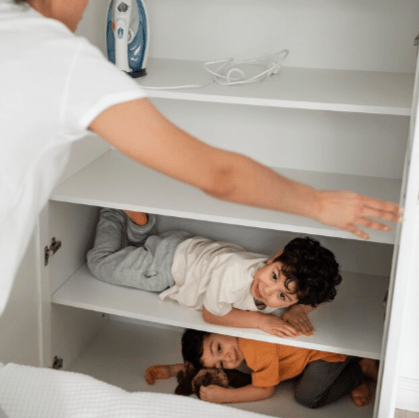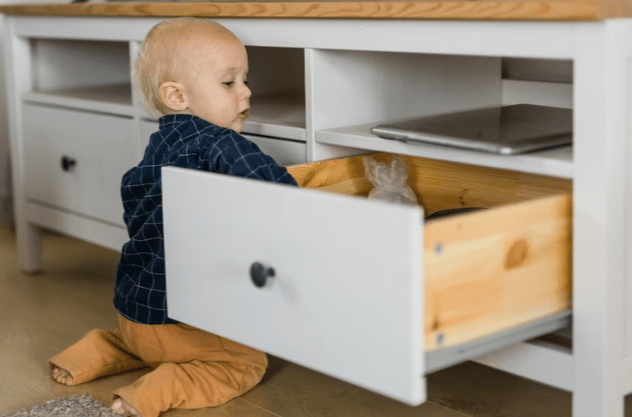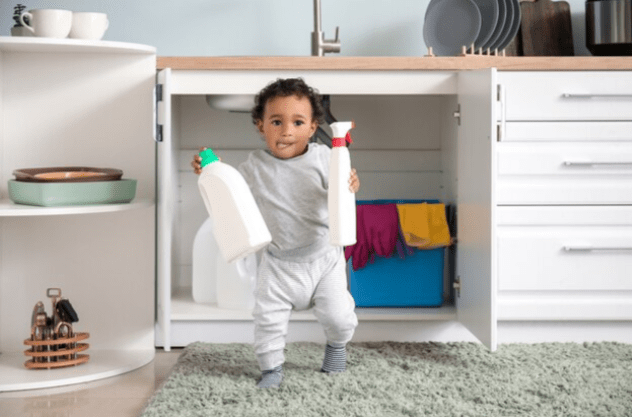Learn vital advice for childproofing drawers to ensure the security of your house. For child safety, educate yourself on locks, latches, and upkeep.
Overview
Parents and caregivers must have childproof drawers to protect young children from threats. This isn’t just about locking up a place; it’s also about ensuring inquisitive toddlers stay safe and healthy while investigating their environment. The procedure implements policies to keep kids away from potentially harmful objects, including small objects that could choke them, sharp objects, or poisonous substances. Although the idea of childproofing may appear simple, it requires careful planning and ongoing maintenance to be successful. This article explores the many aspects of child-safe drawer design. It highlights the significance of childproofing, examines various approaches and products, and offers helpful advice for efficient use. It also emphasizes how important it is to keep a childproofed environment up to date, ensuring that the safety precautions change as the child’s needs and skills do, creating a safe and supportive environment for their growth.
Why Childproofing Drawers Is Important

Drawer childproofing is essential for several reasons. First of all, it aids in averting mishaps and injuries. Drawers frequently hold little items that could cause choking risks, hazardous materials, and sharp objects. Locking these drawers reduces the possibility of wounds, poisoning, or choking. Second, childproofing makes it safer for kids to play and learn in their surroundings. Children who can move around are inherently curious and will explore their environment. Children can explore their curiosity without encountering hazardous objects when drawers are secured. Lastly, knowing that their house is a safer location for their children can provide parents and other caregivers piece of mind after childproofing.
Techniques for Childproofing Cabinets
Drawer childproofing can be done in several ways, each with pros and downsides. The most popular techniques consist of:
Latches and Locks: The drawer can’t open because of the latches and locks that are fitted within. Popular choices include adhesive latches, spring latches, and magnetic locks. Since a magnetic key is required to open them, magnetic locks are incredibly more effective and secure than other types.
Drawer stops: These gadgets stop drawers from being fully drawn out. They accommodate larger drawers that a youngster could accidentally pull out and damage.
Cord and Cable Ties: Drawer handles can be kept together with cord and cable ties as a temporary or do-it-yourself solution to discourage little children from opening them. This approach may not be as safe as sure locks and latches.
Drawer Dividers: By arranging drawers and pushing hazardous objects to the back, dividers—while not a lockable solution—can assist in keeping harmful goods out of reach.
Choosing the Best Childproofing Technique
Take into account the following when selecting a childproofing technique:
Type of Drawers: The best childproofing technique will depend on the construction and design of your drawers. For solid wood drawers, magnetic locks work better, whereas adhesive latches work better on laminated surfaces.
Ease of Use: Select a technique that is simple for adults but complex for kids. An overly complex locking system may deter adults from regularly using the drawers.
Aesthetics: Less obvious childproofing techniques are preferred by some parents. For example, magnetic locks are hidden from view from the outside since they are mounted within the drawer.
Installation: Consider whether you’d instead use adhesive latches, a no-tool approach, or install the childproofing device yourself if you’re comfortable doing so.
Suggestions for Efficient Childproofing
Take into account the following advice to make sure your childproofing efforts are successful:
Start Early: Before your youngster learns to walk, start childproofing. When your child begins to explore, you can ensure your home is safe because of this proactive approach.
Consider Like a Child: Put yourself at your child’s level and scan the area for dangers. You can determine which drawers require locking with the aid of this perspective.
Lock Up All Hazards: Keep an eye out for any drawers that might be holding something dangerous. For young children, even seemingly innocuous objects can be hazardous.
Frequent Inspections: Conduct routine inspections to ensure the childproofing devices are safe and operating correctly. Adhesives may deteriorate with time, and locks may fall loose.
Educate Caregivers: Make sure that the people looking after your child know the need to keep them occupied and can use the childproofing equipment.
Sustaining an Environment Barren to Children

Sustaining a childproofed environment necessitates ongoing awareness and adjustment. Children become more adept at navigating and overcoming obstacles as they age, so it’s essential to review and modify childproofing techniques regularly. Safety devices must be inspected for wear and tear and promptly replaced if necessary to maintain effectiveness. Furthermore, teaching kids about safety and the rationale behind limitations is essential as their comprehension grows. In addition to strengthening the physical barriers, this helps children become more conscious and self-reliant, resulting in a comprehensive strategy for preserving a secure and supportive environment where they can grow.
In Conclusion
Childproofing drawers are essential to creating a safe space where young children can grow and thrive. Understanding the significance of childproofing enables parents and other caregivers to choose and use appropriate safety measures carefully. The risk of mishaps and injuries is significantly reduced by taking a watchful and proactive approach, guaranteeing that the house is a haven of discovery and development for the youngest family members. But childproofing goes beyond just putting up physical barriers. It’s about creating a supportive environment where kids may grow and explore without taking unnecessary risks and bringing comfort to grown-ups. This all-encompassing approach to safety allows kids to explore and learn while giving parents peace of mind that their kids are in the safest and most nurturing environments.
We hope you found this information helpful in creating a safer environment for your family. At GuardWell Safety, we understand that every home is unique, as are your child-proofing needs. That’s why we offer a Free Child-Proofing Consultation tailored to your requirements. Let our experts help you identify potential hazards and provide personalized solutions to make your home a secure haven for your little ones. Book your free consultation today and take the first step towards peace of mind.






